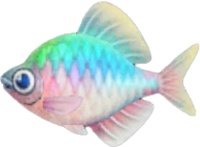Bitterling
- "I caught a bitterling! I wonder what makes this little guy so angry..." —Animal Crossing (GCN)
- "I caught a bitterling! So small, so very bitter!" —Wild World
- "I caught a bitterling! But it's pretty sweet to me!" —City Folk
- "I caught a bitterling! What's it so bitter about?" —New Leaf
- "I caught a bitterling! It's mad at me, but only a little." —New Horizons
| ||||||
 | ||||||
| Real-world info | ||||||
|---|---|---|---|---|---|---|
| Name: Acheilognathus melanogaster (Japanese bitterling) Family: Cyprinidae (carps and minnows) | ||||||
| Main appearances | ||||||
|
| ||||||
| Other appearances | ||||||
Names in other languages
Unknown
Unknown Unknown Unknown
Unknown
Unknown Unknown Unknown
Unknown Unknown Unknown Unknown | ||||||
The Bitterling is a relatively common fish found in all games of the Animal Crossing series. It can be found in the river all day during the months of November to March (May to September on Southern Hemisphere). It sells for 900 Bells, at Nook's Cranny.
Catch details
Animal Crossing
In Animal Crossing, the bitterling can be found in the river all day during the months of December to February. It sells for 1,300 Bells at the Tom Nook's store.
Wild World, City Folk and New Leaf
In Animal Crossing: Wild World, City Folk and New Leaf, the bitterling can be found in the river all day during the months of November to February. It sells for 900 Bells (or 700 in PAL version of Wild World) at the Tom Nook's store or Re-Tail.
Encyclopedia information
Wild World
City Folk
Donating to the Museum
As with all fish in the Animal Crossing series , the Bitterling can be donated to the Museum by talking to Blathers, who will follow the donation up with a small talk.
Animal Crossing
"Even run-of-the-mill, common fish are valuable resources, you see. All part of the grand tapestry, wot!
Wild World
Blathers will say this as the fish is donated:
"I must say, I've never personally considered eating one of these before. It's so very...goldfishy... No, not particularly tasty-looking, to be sure..."
After donation, the Bitterling can be found in the front tank in the first room.
City Folk
Blathers will say this when handed the small fish:
"It's quite common for enthusiasts to keep bitterlings in the same tank as tropical fish, eh wot? Indeed, once upon a time, this fish was a popular choice for the private fishing ponds of the rich!"
It can be found swimming aound in the middle-left tank in the Aquarium after donation.
New Leaf
After donating the Bitterling, the following information will be displayed by its tank:
These fish are so small, they can fit their entire body in the palm of your hand. During mating season, the male's belly turns a light orange in order to properly attract a mate. They live in rivers and lakes and deposit eggs in large bivalves where the eggs hatch and live for a while.
The Bitterling can be found in the larger of the two left-hand tanks in the freshwater fish room.
New Horizons
Upon donation or selecting "Tell me more about this!", Blathers the curator will say:
"Bitterlings hide their eggs inside large bivalves—like clams—where the young can stay safe until grown. The bitterling isn't being sneaky. No, their young help keep the bivalve healthy by eating invading parasites! It's a wonderful bit of evolutionary deal making, don't you think? Each one keeping the other safe... Though eating parasites does not sound like a happy childhood... Is that why the fish is so bitter?"
Further Information
The Rhodeus sericeus, or "Bitterling" is a harmless fish that lives in ponds, lakes, marshes, muddy and sandy pools, as well as the backwaters of rivers. It feeds mainly on plant material, but has been known to feed on small insect larvae. The Bitterling lays its eggs in the mantle cavity of mussels. The bitterlings can be found in central and eastern Europe, and are often seen in public aquariums and can be bought for private aquariums. It is a low-risk fish (not under threat).
Names in other languages
More information on this topic is available at Wikipedia.
| Fish | |||||||||||||||||||||
|---|---|---|---|---|---|---|---|---|---|---|---|---|---|---|---|---|---|---|---|---|---|
| |||||||||||||||||||||